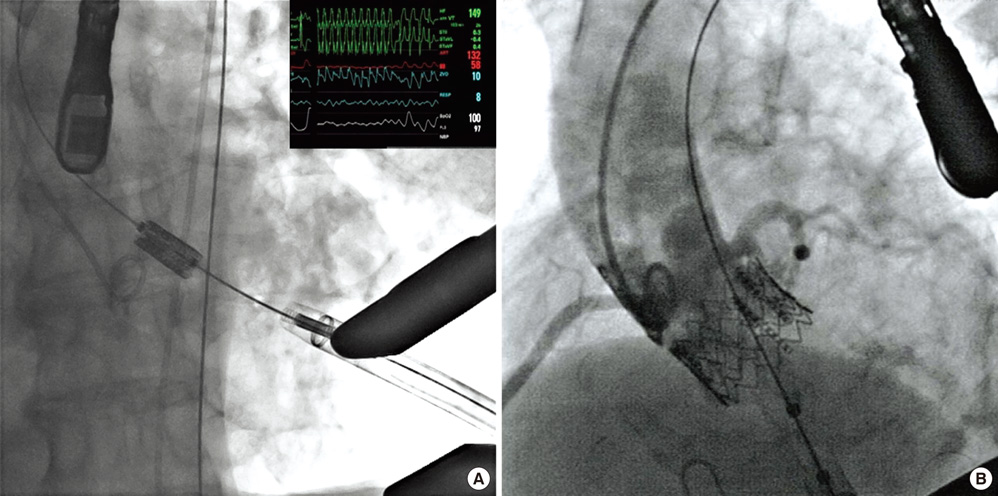J Korean Med Sci.
2011 Apr;26(4):577-579. 10.3346/jkms.2011.26.4.577.
The First Successful Transapical Aortic Valve Implant in Korea
- Affiliations
-
- 1Department of Thoracic and Cardiovascular Surgery, Samsung Medical Center, Sungkyunkwan University School of Medicine, Seoul, Korea. pwpark@skku.edu
- 2Division of Cardiology, Department of Medicine, Samsung Medical Center, Sungkyunkwan University School of Medicine, Seoul, Korea.
- 3Department of Anesthesiology & Pain Medicine, Samsung Medical Center, Sungkyunkwan University School of Medicine, Seoul, Korea.
- KMID: 1777891
- DOI: http://doi.org/10.3346/jkms.2011.26.4.577
Abstract
- Transcatheter aortic valve implantation is an alternative to open heart surgery in high risk patients with severe aortic stenosis. High mortality and complications related to cardiopulmonary bypass for conventional open heart surgery can be avoided with this new less invasive technique. In case of concomitant severe arterial disease, the transapical approach is recommended rather than transfemoral access. An 80-yr-old man with symptomatic aortic stenosis and who had very high surgical risk factors such as diabetes mellitus, hypertension, a history of stroke, bronchial asthma including poor pulmonary function and hepatocellular carcinoma was treated with a transapical aortic valve replacement. The expected mortality in this patient was 25.4% by Euroscore if we performed the conventional aortic valve surgery. The patient was discharged and was well at the 45 follow-up days. We report the first case of successful transcatheter transapical aortic valve implantation which is available recently in Korea.
Keyword
MeSH Terms
Figure
Reference
-
1. Kvidal P, Bergström R, Hörte LG, Ståhle E. Observed and relative survival after aortic valve replacement. J Am Coll Cardiol. 2000. 35:747–756.2. Shin HJ, Kim HJ, Choo SJ, Song H, Chung CH, Song MG, Lee JW. Thoracoscopic aortic valve replacement assisted with AESOP (Automated Endoscope System for Optimal Positioning). Korean J Thorac Cardiovasc Surg. 2005. 38:507–509.3. Ye J, Cheung A, Lichtenstein SV, Carere RG, Thompson CR, Pasupati S, Webb JG. Thoracoscopic Aortic Valve Replacement assisted with AESOP (Automated Endoscope System for Optimal Positioning) 3000. J Thorac Cardiovasc Surg. 2006. 131:1194–1196.4. Chiam PT, Ruiz CE. Percutaneous transcatheter aortic valve implantation: assessing results, judging outcomes, and planning trials: the interventionalist perspective. JACC Cardiovasc Interv. 2008. 1:341–350.5. Webb JG, Pasupati S, Humphries K, Thompson C, Altwegg L, Moss R, Sinhal A, Carere RG, Munt B, Ricci D, Ye J, Cheung A, Lichtenstein SV. Percutaneous transarterial aortic valve replacement in selected high-risk patients with aortic stenosis. Circulation. 2007. 116:755–763.6. Accola KD, Scott ML, Palmer GJ, Thompson PA, Sand ME, Suarez-Cavalier JE, Bott JN, Ebra G. Surgical management of aortic valve disease in the elderly: A retrospective comparative study of valve choice using propensity score analysis. J Heart Valve Dis. 2008. 17:355–364.7. Kawachi Y, Arinaga K, Nakashima A, Toshima Y, Kawano H, Kosuga T. Aortic valve replacement in patients age 70 years and older: early and late results. Artif Organs. 2002. 26:706–710.8. Glock Y, Faik M, Laghzaoui A, Moali I, Roux D, Fournial G. Cardiac surgery in the ninth decade of life. Cardiovasc Surg. 1996. 4:241–245.9. Ye J, Cheung A, Lichtenstein SV, Nietlispach F, Albugami S, Masson JB, Thompson CR, Munt B, Moss R, Carere RG, Jamieson WR, Webb JG. Transapical transcatheter aortic valve implantation: follow-up to 3 years. J Thorac Cardiovasc Surg. 2010. 139:1107–1113.10. Chao VT, Chua YL, Chiam PT, Lee CY, See Tho VY, Tan SY, Sin YK, Hwang NC, Lim ST, Koh TH. Percutaneous transcatheter aortic valve replacement: first transapical implant in Asia. Singapore Med J. 2010. 51:69–72.11. Marcheix B, Lamarche Y, Berry C, Asgar A, Laborde JC, Basmadjian A, Ducharme A, Denault A, Bonan R, Cartier R. Surgical aspects of endovascular retrograde implantation of the aortic CoreValve bioprosthesis in high-risk older patients with severe symptomatic aortic stenosis. J Thorac Cardiovasc Surg. 2007. 134:1150–1156.12. Bleiziffer S, Ruge H, Hörer J, Hutter A, Geisbüsch S, Brockmann G, Mazzitelli D, Bauernschmitt R, Lange R. dictors for new-onset complete heart block after transcatheter aortic valve implantation. JACC Cardiovasc Interv. 2010. 3:524–530.13. Godin M, Eltchaninoff H, Furuta A, Tron C, Anselme F, Bejar K, Sanchez-Giron C, Bauer F, Litzler PY, Bessou JP, Cribier A. Frequency of conduction disturbances after transcatheter implantation of an Edwards Sapien aortic valve prosthesis. Am J Cardiol. 2010. 106:707–712.
- Full Text Links
- Actions
-
Cited
- CITED
-
- Close
- Share
- Similar articles
-
- Expanding transcatheter aortic valve replacement into uncharted indications
- Surgical Management of Aortic Valve Injury after Nonpenetrating Trauma
- Quadricuspid Aortic Valve : Report of Three Cases and Review of the Literature
- Infective Endocarditis involving Aortic Valve, Mitral Valve, Tricuspid Valve, and Interventricular Septum: A Case Report
- Aortic Valve Sparing Operations: A Review


